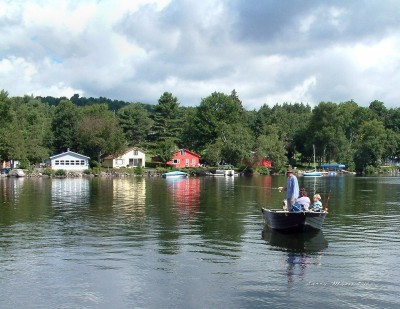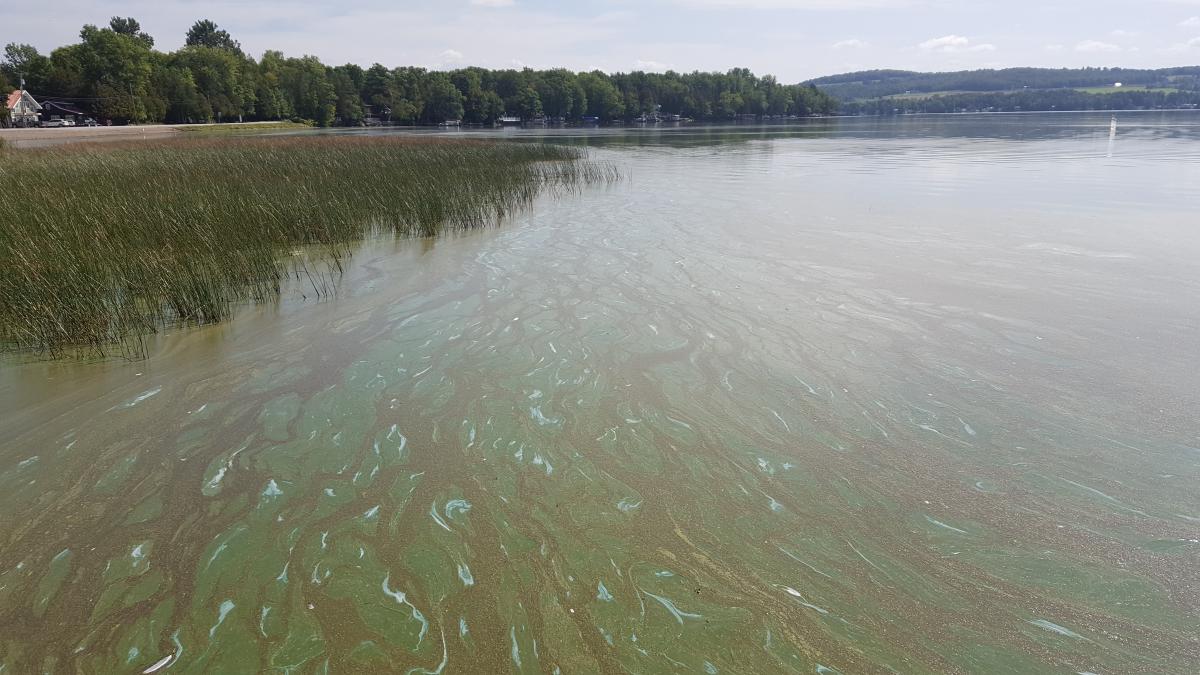
With a 1375-acre surface area, Lake Carmi is the fourth largest natural lake located entirely within Vermont. It is 7.5 miles around, averaging about 20 feet in depth, and is 33 feet at its deepest point. The lake supports northern pike, walleyes, and other warm water species. The lake drains north into Quebec’s Pike River, then into Lake Champlain. Lake Carmi was once much larger. In the thousands of years since the last ice age, the southern end of the original lake has silted in, creating wetland forests and the third largest peat bog in Vermont. Nestled among hills in the town of Franklin, less than a one-hour drive northeast of Burlington, the lake is a popular destination for anglers, birders, boaters, and campers. Lake Carmi State Park offers 173 campsites as well as a boat launch, day-use picnic area, swimming beach, and walking trails.
Lake Carmi has experienced high phosphorus concentrations and the resultant water quality problems for several decades. Late summer algae blooms, reduced water clarity and heavy aquatic plant growth have persisted. In 2008, the Department of Environmental Conservation listed Lake Carmi as “impaired” by phosphorus, i.e. the lake does not meet Vermont Water Quality Standards. Section 303(d) of the U.S. Clean Water Act requires waters that do not meet state water quality standards to have a Total Maximum Daily Load analysis prepared. A “TMDL” identifies a daily amount (“load”) of phosphorus that can enter the lake without causing water quality problems. Since the EPA approved a TMDL in 2009, the Vermont Agency of Natural Resources and Agency of Agriculture have worked together with the Franklin Watershed Committee and other partners to reduce nonpoint sources of phosphorus in the watershed. Despite this ongoing work in the watershed, algae and cyanobacteria blooms in the lake continue to persist in summer and fall, mainly due to internal phosphorus loading from lake sediments.
In 2019, an aeration system was installed in Lake Carmi, with the goal of reducing internal phosphorus loading by eroding the thermal stratification in the lake. This was intended to result in increased oxygen in bottom waters, oxidation of iron and manganese compounds in the bottom water, and as a result the immobilization of phosphorus stored in the sediments. In some respects, the aeration system performed as intended. When on, it was usually able to remove thermal stratification in the water column, introducing at least some dissolved oxygen down to the deep waters and maintaining concentrations above 2 ug/L at 9 m depth, which was the stated target. That being said, the system was not able to effectively reduce surface water phosphorus concentrations or cyanobacteria blooms, and seems to have had the opposite effect. Therefore, the aeration system was not operated in 2024, and removal is planned for 2025.
In 2024, a comprehensive feasibility study was conducted by Barr Engineering to evaluate the expected water quality benefits and costs of an in-lake aluminum treatment to control internal phosphorus loading in Lake Carmi. When alum (aluminum sulfate) is added to a lake, phosphate is removed in the water column through precipitation forming a floc that settles to the lake bottom. This floc layer forms a barrier to internal phosphorus loading from the sediment. For more information on alum, the North American Lake Management Society has a webpage on The Use of Alum for Lake Management, including a position statement that "Alum is a safe and effective lake management tool."
There has been extensive research done during the course of the aeration period and the years immediately preceding, including work by DEC staff, UVM researchers, and Barr Engineering (as part of the alum feasibility study). This work has included regular field sampling by DEC staff, and ongoing work by the Lay Monitoring Program and the Cyanobacteria Monitoring Programs. It also includes deployment of an automated profiling buoy (by UVM) as well as extensive additional research by UVM students including sediment geochemical analyses, phytoplankton taxonomy, and satellite image analysis.
This page serves as a central location for information about monitoring and management of Lake Carmi’s water quality, with emphasis on actions in the watershed and in-lake processes.

